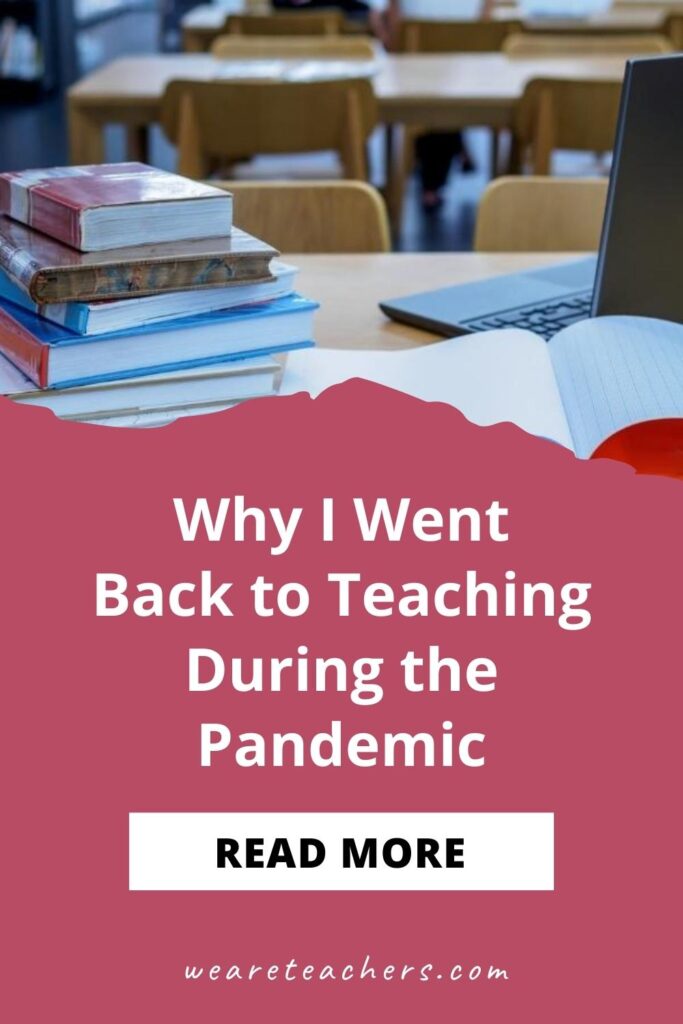There’s been a mass exodus of teachers during the past three years. We see a lot of stories about educators quitting and how the profession is toxic. But in spite of the challenges, last year I chose to go back to the classroom after a six-year break. Here’s what happened.
Helpful instead of helpless …
When schools closed in March 2020, like so many, I felt helpless. I never imagined in my lifetime that schools would have to change so radically overnight. I began to read about inspiring teachers who were rising to the challenge in service of our kids. Feeling encouraged and inspired, I updated my resume and started interviewing for teaching jobs. I was nervous! I had been out of the classroom for six years. When I told people what I was doing, they looked at me like I was crazy, and maybe I was, but I know this: I wanted to be helpful instead of feeling helpless.
A community that cares …
After I left teaching, I worked remotely. At first I appreciated the flexibility. I could arrange my schedule, which meant I didn’t have to get a sub when I took my son to the doctor, and I could wear jeans (and even PJs!). While these perks were exciting at first, they lost their allure when COVID hit. The line between home and school was blurred. I found myself working more and spending too much time on screens. There were days when, other than email or Slack messages, I didn’t speak to a single colleague. I missed working in a school where I was part of a community. I missed seeing the impact of my work when a student had an aha moment or thanked me for my lesson. While teaching isn’t flexible, and there have been some very hard days, I know I am not alone. Every day I show up knowing that at our school we are going to do the best we can to help our students feel safe and cared for so they can learn. I am part of a community that cares.
Transferable skills transfer …
When I left the classroom in 2015, schools were just beginning to use learning management systems, Chromebooks, and iPads. For the next six years, I worked for private education companies coaching teachers, designing and facilitating professional development, and writing about education. Through these jobs, I learned many new skills, which prepared me for pandemic teaching: I was a Zoom expert, and I worked asynchronously daily. I wasn’t teaching, but I was learning how to navigate working virtually. If you have left the classroom or plan to, know that you can always come back, and when you do, you will come back stronger. My time away from the classroom was time I needed to remember why I became a teacher in the first place, and the changes I needed to put in place so I didn’t leave again. Working for private companies helped me learn how to set boundaries, advocate for myself, and approach teaching like a job, not a calling. I’m a healthier and happier teacher because I can now say “I’d love to help, but I can’t” and “I don’t work outside my contract hours.”
An investment in our future …
I am not naive about what it means to be a teacher in our society. We are underpaid, overworked, and scrutinized. We worry about school shootings, getting COVID or giving it to our families, and many of us have to work two jobs to make ends meet. One of the reasons I left the classroom in the first place was because my salary barely covered day-care costs. I was resentful that I took better care of other people’s children than my own. I still feel this way from time to time, but I see the bigger picture: our kids are our future. For many students, school is the only place where they feel safe and know they will have food to eat and an adult to care for them and teach them. How can I expect teachers to keep showing up for my kids and not do the same for their kids? It takes a village, and at the end of the day, being a part of that village is what matters to me.
Have you gone back to teaching after a break? What was it like? Please share in the comments.
Plus, for more articles like this, be sure to subscribe to our newsletters.


